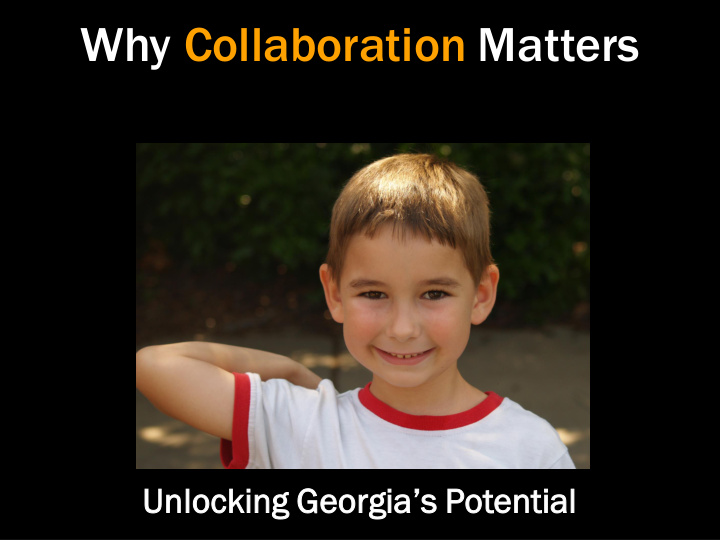



Why Collaboration Matters Unlocking Georgia’s Potential
Georgia ’ s youth and social services organizations before 1990
In 1990 Georgia Ranked 48 th in the nation in child well-being
Collaborative organizations in 159 counties committed to improving the quality of life for children and families
Only network of its kind in the nation
Collaboration We began to work together by convening in communities, across state agencies, within public-private sectors to assess data, create a strategic annual plan based on the data, and evaluate the outcome each year.
We bring together at the same table — the social worker, the nurse, the sheriff, the BOE Superintendent, the minister, the business person, the public servant, parents, and community members and then help them to figure out the best way for their children and families to thrive.
Today 27% of Georgia's children live in poverty Georgia has the 5 th worst child poverty rate in the nation .
But Als lso Today The number of kids not graduating on time has dropped by 21% in the past decade.
Georgia’s teen n birth rate has dropp pped ed drama matical tically in the past two decades. es.
Our Vision That all children in Georgia are healthy, ready to start school and do well when they get there, that every family is stable and self-sufficient, and that communities are strong.
Core Principles ‣ Collaboration ‣ Local decision-making ‣ Accountability ‣ Public-private partnerships ‣ Leveraging resources
County Collaboratives Identify local prioritie s and needs, manage their own planning process , share resources, and evaluate programs and practices.
County Collaboratives Hold themselves accounta tabl ble for results of their work by tracking locally selected indicators of child well-being using KID IDS COUNT T data.
Georgia Family Connection leverages $5 for every $1 of state funding.
A public-private nonprofit intermediary that supports the Georgia Family Connection statewide network
Statewide Initiatives
Low Birthweight
“ The single most important predictor that a baby will die in the first year is that the baby is born small. ” Juan Acuña, MD, M. Sc. Professor Obstetrics and Gynecology Florida International University
Childhood Obesity
35% of Georgia’s children are obese or overweight. 43% failed to attain a healthy fitness zone.
Two million Georgians, including half a million children, live in lower-income communities where it’s difficult to access healthy food.
Increasing fresh, h, affo ford rdabl able food reta tail in underserved urban neighborhoods and rural communities will help: • address this growing health problem, and • boost Georgia ’ s economy.
Early Childhood — Grade-Level Reading
Increasing Georgia’s graduation rate begins in your community.
Contact your local Family ly Connect nection ion Coordin inat ator or. . Attend nd coll llabora borativ ive e meet etin ings s and det etermi mine ne how you can contribut ribute to the curre rent nt work rk.
Bring with you your knowledge of resources available and current data regarding students with disabilities…….
and ask for community participation in convenin ening g to discu cuss and imp mplem lement ent solut lutions ions for increasing graduation rates among students with disabilities
“ Community involvement and local decision-making are vital to addressing the issues facing our citizens .” -Governor Nathan Deal
Find your county Collaborative at www.gafcp.org Lisa Brewer Community Support Specialist Regions 11 and 12 GA Family Connection Partnership (912) 271-6373 Lisa@gafcp.org
Recommend
More recommend